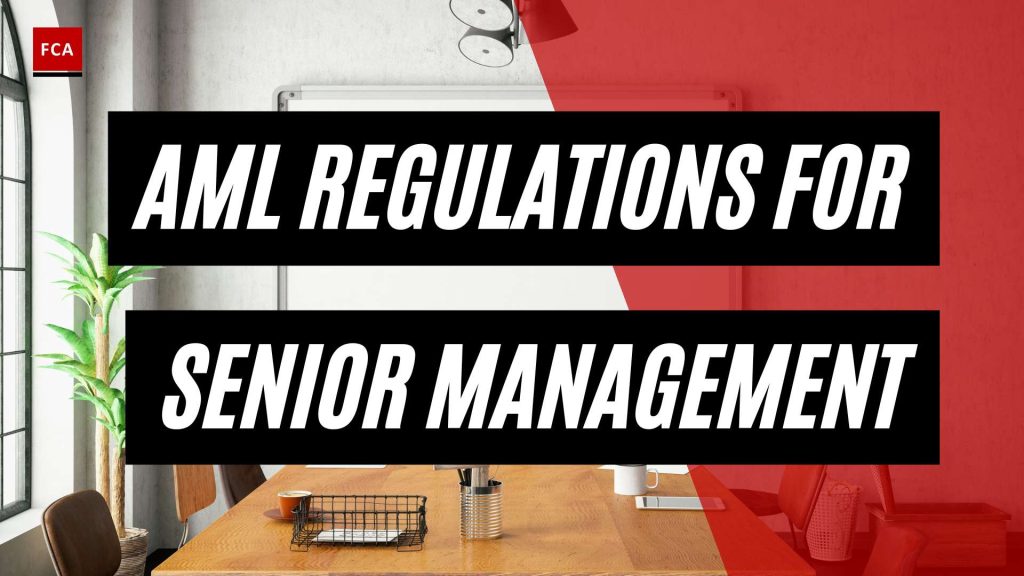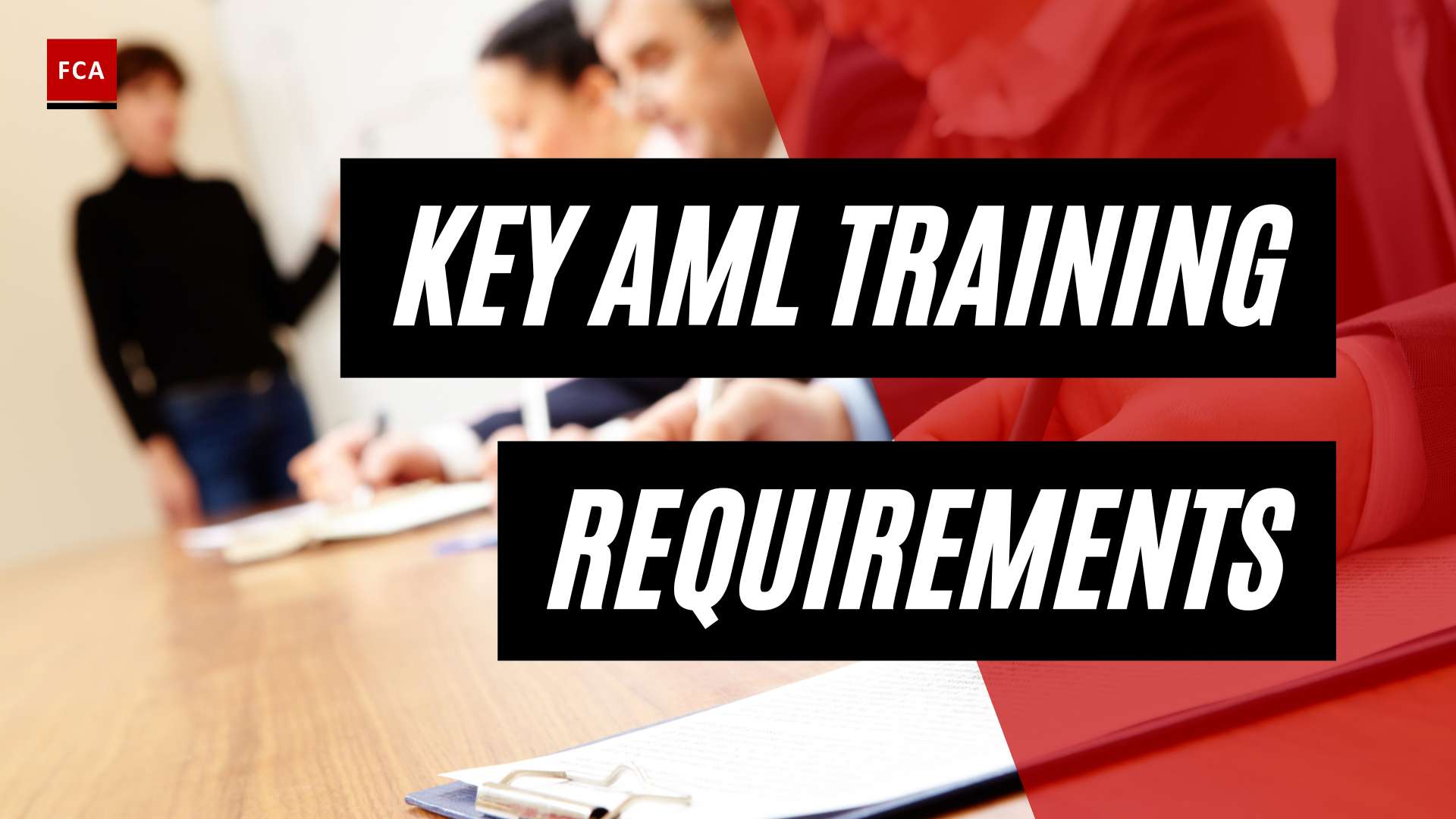Understanding AML Training for Senior Management
In the realm of Anti-Money Laundering (AML) compliance, it is crucial for senior management to receive proper training to effectively fulfill their responsibilities. AML training for senior management is essential in ensuring the integrity of financial systems and protecting organizations from financial crime. Let’s explore the importance of AML training for senior management and the regulatory expectations placed upon them.
Importance of AML Training for Senior Management
Senior management plays a pivotal role in establishing a strong culture of compliance within their organizations. They are responsible for setting the tone from the top and demonstrating a commitment to AML regulations. By receiving comprehensive AML training, senior management can develop a deep understanding of the risks associated with money laundering and terrorist financing, enabling them to make informed decisions and provide effective leadership.
Proper AML training equips senior management with the knowledge and skills necessary to oversee AML controls and compliance programs. It enables them to effectively communicate the importance of AML regulations to their teams, fostering a culture of compliance throughout the organization. AML training also helps senior management identify potential red flags and suspicious activities, allowing them to take appropriate action to mitigate risks and ensure regulatory compliance.
Regulatory Expectations for Senior Management
Regulatory authorities hold senior management accountable for the effectiveness of their organizations’ AML controls and compliance programs. Senior management is expected to exhibit leadership and commitment to AML regulations, implementing appropriate policies and procedures to prevent money laundering activities (Financial Crime Academy). Regulatory interventions, reputational damage, and financial losses can result from the lack of oversight and control by senior executives (Financial Crime Academy).
To meet regulatory expectations, senior management must stay informed about the evolving AML landscape and ensure that their institutions’ procedures are up to date and effective in detecting and preventing money laundering activities. Continuous training and awareness programs for staff members are essential to enhance overall AML compliance efforts. Senior management must also actively participate in risk management, governance, monitoring, and reporting activities related to AML compliance (Financial Crime Academy).
By receiving comprehensive AML training, senior management can fulfill their regulatory responsibilities, mitigate risks, and protect their organizations from legal and regulatory consequences. AML training empowers senior management to make informed decisions and lead their teams in upholding the highest standards of AML compliance.
In the next sections, we will delve into the specific responsibilities of senior management in AML compliance, the key elements of AML compliance programs, the consequences of non-compliance, and the role of senior management in AML regulations for professional services.
Responsibilities of Senior Management in AML Compliance
When it comes to Anti-Money Laundering (AML) compliance, senior management plays a crucial role in ensuring that financial institutions adhere to regulatory requirements and effectively combat money laundering and terrorist financing. By demonstrating leadership and commitment to AML regulations, senior management sets the tone from the top and fosters a culture of compliance within their organizations.
Leadership and Commitment to AML Regulations
Senior management holds the responsibility of implementing appropriate policies and procedures to prevent money laundering activities. It is essential for them to lead by example and exhibit a strong commitment to AML regulations. By actively promoting and supporting AML training programs and emphasizing the importance of compliance, senior management can ensure that all employees understand the significance of their role in detecting and preventing money laundering activities.
Overseeing AML Controls and Compliance Programs
Regulatory authorities expect senior management to oversee AML controls and compliance programs within financial institutions. This includes ensuring that robust systems, policies, and procedures are in place to prevent money laundering and terrorist financing. By actively monitoring the effectiveness of these controls and programs, senior management can identify any weaknesses or gaps and take appropriate measures to address them. Regular assessments and internal audits are essential to evaluate the institution’s compliance with AML regulations.
Staying Informed and Updating Procedures
The AML landscape is constantly evolving, with new money laundering techniques and regulatory updates emerging. Senior management must stay informed about these changes and ensure that their institutions’ procedures remain up to date and effective in detecting and preventing money laundering activities. This requires continuous education and training to enhance the overall AML compliance efforts of the institution. By providing ongoing training and awareness programs to staff, senior management can reinforce the importance of AML compliance and equip employees with the necessary knowledge and skills to fulfill their responsibilities effectively.
By fulfilling their responsibilities in AML compliance, senior management can mitigate the risk of regulatory enforcement actions, protect the reputation and integrity of their institutions, and contribute to the overall effectiveness of the AML framework. Their active involvement in overseeing AML controls, demonstrating commitment to regulations, and staying informed about changes in the AML landscape is essential for maintaining a strong and robust AML compliance program within financial institutions.
Key Elements of AML Compliance for Senior Management
When it comes to anti-money laundering (AML) compliance, senior management plays a critical role in ensuring that their organizations adhere to the necessary regulations. There are three key elements that senior management must focus on to maintain effective AML compliance: policies and procedures, risk assessments and due diligence, and monitoring and reporting suspicious activities.
Policies and Procedures
Clear and comprehensive AML policies and procedures are the foundation of any effective compliance program. Senior management must ensure that these policies and procedures are in place and regularly updated to reflect changes in AML regulations. These policies should outline the institution’s commitment to AML compliance, define the roles and responsibilities of employees, and provide guidelines for detecting and reporting suspicious activities.
Furthermore, policies and procedures should include guidelines for customer due diligence (CDD) and know your customer (KYC) processes. These processes help organizations identify and verify the identities of their customers, assess their risk profiles, and monitor their transactions. By implementing robust policies and procedures, senior management can demonstrate their commitment to AML compliance and set the tone for the entire organization.
Risk Assessments and Due Diligence
Risk assessments and due diligence are crucial components of an effective AML compliance program. Senior management must ensure that their organizations conduct regular risk assessments to identify and assess the money laundering and terrorist financing risks inherent in their products, services, and customer base. These assessments help determine the appropriate level of due diligence required for different types of customers and transactions.
Due diligence measures, such as KYC processes, enable organizations to obtain relevant information about their customers and assess the potential risks associated with their activities. By implementing robust due diligence procedures, senior management can ensure that their organizations are not inadvertently involved in money laundering or other illicit activities.
Monitoring and Reporting Suspicious Activities
Another key element of AML compliance for senior management is the establishment of effective systems for monitoring and reporting suspicious activities. Senior management must ensure that appropriate controls and monitoring mechanisms are in place to detect and investigate any unusual or suspicious transactions. This includes implementing transaction monitoring systems, conducting periodic reviews, and training staff to recognize red flags and report suspicious activities.
In addition to monitoring, senior management must establish a clear and efficient process for reporting suspicious activities to the relevant authorities. Prompt reporting of suspicious transactions is essential for combating money laundering and other financial crimes. By developing robust monitoring and reporting mechanisms, senior management can help safeguard their organizations from potential risks and ensure compliance with AML regulations.
By focusing on these key elements of AML compliance, senior management can demonstrate their commitment to preventing money laundering and other financial crimes within their organizations. It is crucial for senior management to provide the necessary leadership and oversight to ensure that AML policies and procedures are effectively implemented, risk assessments are conducted regularly, and adequate controls are in place to monitor and report suspicious activities. By doing so, senior management can create a culture of compliance and safeguard their organizations from legal and regulatory consequences, as well as reputational damage and financial losses.
Consequences of Non-Compliance for Senior Management
When it comes to Anti-Money Laundering (AML) regulations, senior management within financial institutions holds a crucial responsibility to ensure compliance. Failing to meet these obligations can result in severe consequences, both legally and financially. It is essential for senior management to understand the potential ramifications of non-compliance and the importance of upholding AML regulations.
Legal and Regulatory Consequences
Regulatory authorities hold senior management accountable for ensuring that their financial institutions have robust AML controls in place. The lack of oversight and control by senior executives could lead to regulatory interventions, penalties, and fines. In some cases, non-compliance may result in criminal prosecution, disqualification from managing a company, and imprisonment for up to two years (Financial Crime Academy).
To avoid such legal and regulatory consequences, senior management must take a proactive approach in monitoring and addressing AML risks. By demonstrating diligence in overseeing AML compliance, they can mitigate the risk of regulatory enforcement actions and protect the reputation and integrity of their institutions.
Reputational Damage and Financial Losses
Non-compliance with AML regulations can have significant reputational consequences for financial institutions. News of non-compliance can quickly spread, eroding trust and confidence in the institution among clients, investors, and the general public. Reputational damage can have far-reaching effects, including loss of business, difficulty in attracting new clients, and potential legal actions from affected parties.
Financial institutions that fail to meet AML obligations may also face financial losses. Regulatory fines and penalties can be substantial, impacting the institution’s profitability and financial stability. Additionally, the cost of remediation efforts to address compliance deficiencies can be significant, including investments in enhanced monitoring systems, training programs, and legal support.
To protect against reputational damage and financial losses, senior management must prioritize AML compliance. They need to provide adequate resources, support, and commitment to maintaining a strong culture of compliance within the organization. This includes promoting a zero-tolerance approach towards financial crime, staying informed about evolving AML regulations, and ensuring that their institutions’ procedures are up to date and effective in detecting and preventing money laundering activities (Financial Crime Academy).
By understanding and complying with AML regulations, senior management can safeguard their institutions’ reputation, financial standing, and legal integrity. It is crucial for senior management to prioritize AML compliance, allocate resources effectively, and foster a culture of compliance throughout the organization.
Role of Senior Management in AML Regulations for Professional Services
Senior management within professional services organizations plays a crucial role in ensuring compliance with Anti-Money Laundering (AML) regulations. They have the responsibility to provide effective governance, manage risks, allocate resources, and foster a culture of compliance throughout the organization. Let’s explore the key aspects of their role in AML regulations for professional services.
Governance and Risk Management
Senior management must actively participate in governance and risk management processes related to AML compliance. This includes providing leadership, setting strategic objectives, and establishing a framework for managing AML risks. They should have a clear understanding of the AML regulations applicable to their industry and ensure that appropriate policies and controls are in place to mitigate these risks.
To effectively manage AML risks, senior management needs to have a comprehensive understanding of the institution’s products, services, and customer base. This enables them to assess the inherent risks and implement controls to detect and prevent money laundering and terrorist financing activities. By prioritizing governance and risk management, senior management sets the tone for the organization and reinforces the importance of compliance with AML regulations.
Designated Money Laundering Reporting Officers
Designated Money Laundering Reporting Officers (MLROs) play a critical role in implementing and overseeing AML regulations within professional services organizations. MLROs act as a key point of contact for reporting suspicions of money laundering, ensuring that appropriate internal reporting mechanisms are in place. They are responsible for managing the compliance program, providing guidance to staff, and ensuring that training programs are effectively implemented.
Senior management must appoint competent individuals as MLROs and provide them with the necessary authority, resources, and support to carry out their responsibilities effectively. MLROs should have a deep understanding of AML regulations, keep abreast of regulatory developments, and ensure that the organization’s AML compliance program remains up to date.
Resource Allocation and Culture of Compliance
Senior management is responsible for allocating adequate resources to support the implementation of AML regulations within professional services organizations. This includes allocating sufficient budget, staffing, and technology to effectively manage AML risks and comply with regulatory requirements. By providing the necessary resources, senior management demonstrates their commitment to AML compliance and creates an environment where staff can carry out their responsibilities effectively.
Furthermore, senior management plays a crucial role in fostering a culture of compliance throughout the organization. They should promote a zero-tolerance approach towards financial crime and reinforce the importance of AML regulations. This includes promoting awareness, providing regular training, and encouraging staff to report any suspicions of money laundering or other illicit activities. By instilling a culture of compliance, senior management empowers staff to actively contribute to the organization’s AML compliance efforts.
In summary, senior management in professional services organizations have a vital role to play in ensuring compliance with AML regulations. Through effective governance, risk management, designated MLROs, resource allocation, and fostering a culture of compliance, they contribute to the overall effectiveness of the organization’s AML compliance program. By fulfilling their responsibilities, senior management safeguards the institution’s reputation, protects against financial losses, and helps maintain the integrity of the financial system.
Implementing Effective AML Compliance Programs
To stay ahead of financial crime and ensure compliance with Anti-Money Laundering (AML) regulations, senior management must implement effective AML compliance programs. These programs should be tailored to the specific risks and needs of the company, taking into account the ever-evolving landscape of financial crime. Let’s explore three key elements of implementing an effective AML compliance program for senior management.
Tailoring the Program to the Company’s Risks
Developing an AML compliance program that is specifically tailored to the unique risks and characteristics of the company is crucial in protecting companies from AML fines and penalties. This involves conducting regular risk assessments to identify and mitigate money laundering risks effectively. By understanding the specific risks associated with their industry, clientele, and geographic locations, senior management can design and implement appropriate controls and procedures to address those risks (Sanction Scanner).
Know Your Customer (KYC) Procedures
Know Your Customer (KYC) procedures are a fundamental component of any effective AML compliance program. These procedures involve verifying the identity of customers and assessing their risk profiles to prevent facilitating criminal activity. By implementing robust KYC procedures, senior management can ensure that the company’s interactions with customers are compliant with AML regulations and help detect and prevent money laundering and other illegal financial activities (Sanction Scanner).
Internal Audits and Reviews
Regular internal audits and reviews are essential for companies to ensure compliance with AML regulations, avoid fines and penalties associated with non-compliance, and protect themselves from AML-related risks. These audits and reviews serve as a means of evaluating the effectiveness of the AML compliance program, identifying any weaknesses or areas for improvement, and ensuring that the program remains up to date with regulatory requirements. By conducting internal audits and reviews, senior management can maintain a proactive approach to compliance and demonstrate their commitment to combating financial crime (Sanction Scanner).
By implementing an AML compliance program tailored to the company’s risks, establishing robust KYC procedures, and conducting regular internal audits and reviews, senior management can demonstrate their commitment to AML regulations and protect the company from the legal, regulatory, reputational, and financial consequences of non-compliance. These efforts contribute to building a strong culture of compliance and help safeguard the company’s reputation and integrity in the face of evolving financial crime risks.
Protecting Companies from AML Fines and Penalties
To safeguard companies from AML fines and penalties, it is crucial to understand the AML regulations and compliance requirements that apply to their industry. AML regulations are laws and policies designed to prevent money laundering and other illegal financial activities. These regulations are applicable to various industries, including banking, financial services, and businesses dealing with money and financial transactions. By familiarizing themselves with these regulations, companies can establish a robust compliance framework that mitigates the risk of non-compliance and potential penalties (Sanction Scanner).
Understanding AML Regulations and Compliance Requirements
Companies must thoroughly comprehend the AML regulations and compliance requirements relevant to their industry. This involves staying updated with any changes or amendments to these regulations. A thorough understanding of these requirements enables companies to develop effective AML compliance programs tailored to their specific risks and needs. By addressing the specific compliance obligations outlined in the regulations, companies can enhance their ability to protect themselves from AML fines and penalties (Sanction Scanner).
Developing an AML Compliance Program
Developing an AML compliance program is a key step in protecting companies from AML fines and penalties. The program should be tailored to the company’s specific risks and operations. It should include comprehensive policies and controls that outline the procedures for identifying and mitigating money laundering risks. Conducting regular risk assessments and due diligence is crucial to identify and address potential vulnerabilities. This allows companies to implement adequate measures to prevent and detect money laundering activities before they occur. By developing an effective AML compliance program, companies can demonstrate their commitment to compliance and minimize the risk of non-compliance penalties (Sanction Scanner).
Monitoring and Reporting Suspicious Activities
Monitoring and reporting suspicious activities play a crucial role in protecting companies from AML fines and penalties. Ongoing monitoring of customer transactions allows companies to detect potential money laundering or other criminal activities. By implementing robust monitoring systems, companies can identify unusual patterns, high-risk transactions, and other red flags that may indicate illicit activities. When suspicious activities are identified, it is essential to report them promptly to the appropriate authorities. This proactive approach not only helps prevent money laundering but also demonstrates a commitment to compliance and cooperation with regulatory authorities. By maintaining a strong monitoring and reporting system, companies can protect themselves from AML fines and penalties (Sanction Scanner).
To ensure the effectiveness of their AML compliance efforts, companies should also consider conducting internal audits and reviews. These audits help assess the adequacy and efficiency of their AML compliance programs, identify areas for improvement, and address any non-compliance issues. By regularly reviewing and enhancing their AML compliance programs, companies can demonstrate a strong commitment to compliance, reduce the risk of non-compliance penalties, and safeguard their reputation and financial standing (Sanction Scanner).
Building a Strong AML Compliance Program
When it comes to combating money laundering and ensuring compliance with anti-money laundering (AML) regulations, organizations must establish a robust AML compliance program. Such a program sets the foundation for an organization’s compliance operations, providing guidelines for risk and compliance teams to identify and combat money laundering (Unit21). In this section, we will explore three key elements of building a strong AML compliance program: a designated compliance officer, compliance policies and controls, and training programs and independent audits.
Designated Compliance Officer
An essential component of an effective AML compliance program is the appointment of a designated compliance officer. This individual serves as the central point of contact for AML-related matters within the organization. The compliance officer is responsible for overseeing and managing the organization’s AML efforts, ensuring that policies and procedures are implemented and followed.
The designated compliance officer plays a crucial role in coordinating and communicating with various departments, including risk management, legal, and operations. They serve as a liaison between the organization and regulatory authorities, ensuring that the organization remains up to date with the latest AML regulations and requirements.
Compliance Policies and Controls
To establish a strong AML compliance program, organizations must develop comprehensive AML compliance policies and controls. These policies outline the organization’s commitment to compliance and provide guidance on how to detect, prevent, and report suspicious activities.
The policies should cover various aspects, including customer due diligence, transaction monitoring, record-keeping, and reporting obligations. By clearly defining these policies, organizations can ensure consistency in their AML efforts and minimize the risk of non-compliance.
Additionally, implementing key controls and procedures is vital for effective AML compliance. These controls may include customer identification and verification processes, enhanced due diligence for high-risk customers, and ongoing monitoring of customer transactions. By establishing and adhering to these controls, organizations can better identify and mitigate potential money laundering risks.
Training Programs and Independent Audits
A well-rounded AML compliance program includes comprehensive training programs for staff at all levels of the organization. Training should cover AML regulations, the organization’s policies and procedures, and the identification and reporting of suspicious activities. By providing regular training, organizations can ensure that employees are equipped with the knowledge and skills necessary to fulfill their AML compliance responsibilities.
Furthermore, conducting independent audits and reviews is crucial for evaluating the effectiveness of the AML compliance program. Audits help identify any gaps or weaknesses in the program, allowing organizations to make necessary improvements. These audits may be conducted internally or by external third-party firms specializing in AML compliance.
By continuously refining and enhancing the AML compliance program through training programs and independent audits, organizations can stay ahead of evolving AML regulations and mitigate the risk of non-compliance.
Building a strong AML compliance program requires a designated compliance officer, robust compliance policies and controls, and ongoing training programs and independent audits. By implementing these key elements, organizations can foster a culture of compliance, effectively combat money laundering, and ensure adherence to AML regulations.








